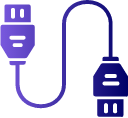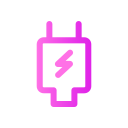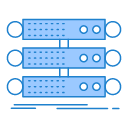Here you will find all answers that you want to know about solitine.


Category 5 enhanced cabling, also known as Cat5e, is an improvement on Cat5 cabling. It was made to support 1000 Mbps "gigabit" speeds, so in theory, it's faster than Cat5. It it also cuts down on crosstalk, the interference you can sometimes get between wires inside the cable.

Get the most state-of-the-art connection currently possible for your networking needs by providing a solid foundation with CAT6 and CAT6a patch cords and backbone cables. With everything from snagless patch cords for added strain relief to angled cables for hard-to-access places, from economical voice/data options to industrial cords for harsh environments, our CAT6 solutions will satisfy your data connection needs both within the data center, or from building to building. Individual pre-terminated patch cords are available in specified lengths, or order bulk cabling by the foot and terminate them yourself. Available options for these Ethernet CAT6 & CAT6a cables include plenum, shielded, augmented and outdoor examples to meet the needs of your specific application.

Low smoke zero halogen or low smoke free of halogen (LSZH or LSOH or LS0H or LSFH or OHLS) is a material classification typically used for cable jacketing in the wire and cable industry. LSZH cable jacketing is composed of thermoplastic or thermoset compounds that emit limited smoke and no halogen when exposed to high sources of heat. Most network cables are insulated with polyethylene, PVC or thermoplastic polyurethane. In a fire, a chlorine-containing plastic material releases hydrogen chloride, a poisonous gas that forms hydrochloric acid when it comes in contact with water. Designated halogen-free cables, on the other hand, do not produce a dangerous gas/acid combination when exposed to flame. However, gases produced by all burning materials whether LSZH or not are extremely toxic. Low smoke zero halogen cable reduces the amount of toxic and corrosive gas emitted during combustion. This type of material is typically used in poorly ventilated areas such as aircraft, rail cars or ships. It is also used extensively in the railroad industry, wherever high voltage or track signal wires must be run into and through underground tunnel systems. This reduces the chance of toxic gasses accumulating in these areas should the wires be damaged by fire or a short circuit fault. Low smoke zero halogen is becoming very popular and, in some cases, a requirement where the protection of people and equipment from toxic and corrosive gas is critical like in the railway industry and shipbuilding industry.

The physical differences are very distinct. A polyvinyl cable feels very soft and is smooth, while an LSZH cable feels rough and is stiffer. However the advantage of the LSZH cable comes with heat. When a PVC cable is set on fire, it emits chemical fumes and acids -which is not very healthy for your personnel-. Whereas an LSZH cable does not emit these chemical substances. This means that the LSZH cable meet the health and safety standards. Not every new building requires these health and safety standards though and the peformance of both cables remains the same.

The TIA standard does not determine the length of un-sheathing; however, it is a good practice to remove the minimum you need for termination. Maintaining the twist is what is important (0.5" from termination point TIA/EIA-568.1 section 10.2.3) to keep the balance of the twisted pairs from being disturbed excessively to minimized near-end cross talk (NEXT).

No. As long as you have a surface that is capable of bearing the combined weight of a unit and the equipment inside of it, mounting a cabinet is quite simple. You need a level, a Phillips-head screwdriver, wall mounting hardware, and any other tools appropriate for wall mounting. To install a cabinet under a desk, table or counter, use an optional Rolling Caster Kit, available separately from Tripp Lite, which will assist you in moving the cabinet.

Absolutely. Most Wall Mount Rack Cabinets are constructed of sturdy steel frames with securely locking front doors, side panels and wall brackets. Perforated front doors and side panels permit generous airflow to keep equipment operating safely.

Most people use Wall Mount Rack Cabinets to house standard rackmount equipment, such as servers, switches and routers, but as long as the total weight inside of a cabinet does not exceed the cabinet's weight capacity, a Wall Mount Rack Cabinet can house any kind of equipment that requires extra protection and security. A Wall Mount Rack Cabinet is essentially a locking, steel-framed cabinet.

The optional Rolling Caster Kit adapts Wall Mount Rack Cabinets to free-standing and roll-away applications under desks, counters and tables. Additional SOLITINE Cooling Solutions and Rack Accessories are also available, such as air conditioning units, heat removal systems, airflow and cable management products, rack shelves and mounting hardware.

It greater overall depth of a rack cabinet for example 900mm or more vs 800mm or less in a server cabinet allows more space to the front and rear of the cabinet for routing cables, also provides additional space for mounting equipment, enhances cable management as well as airflow indispensable in cooling server cabinets and enclosures.

An extensive range of cabinets is available including: EMC, IP65, server cabinet, outdoor electrical box, server racks, data cabinets, outdoor cabinet, marshalling kiosks and utilities enclosures to suit your application.